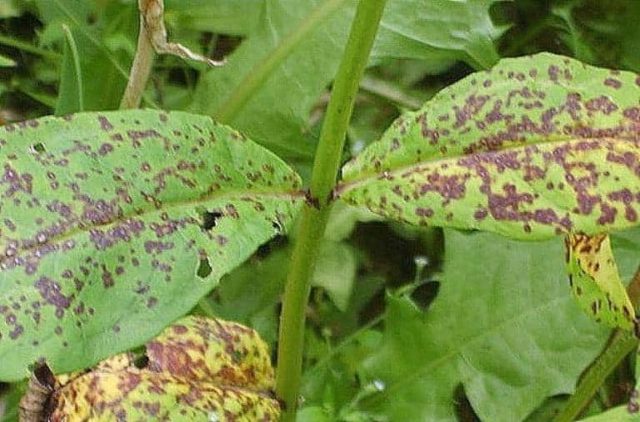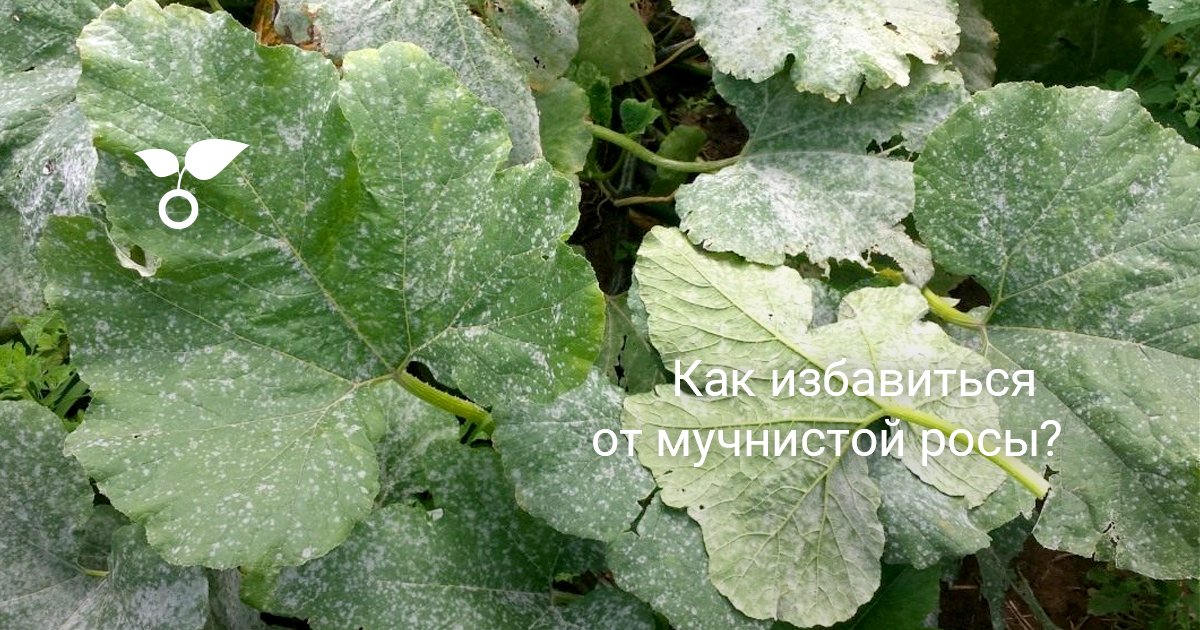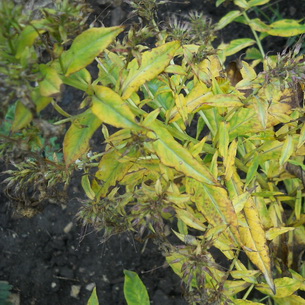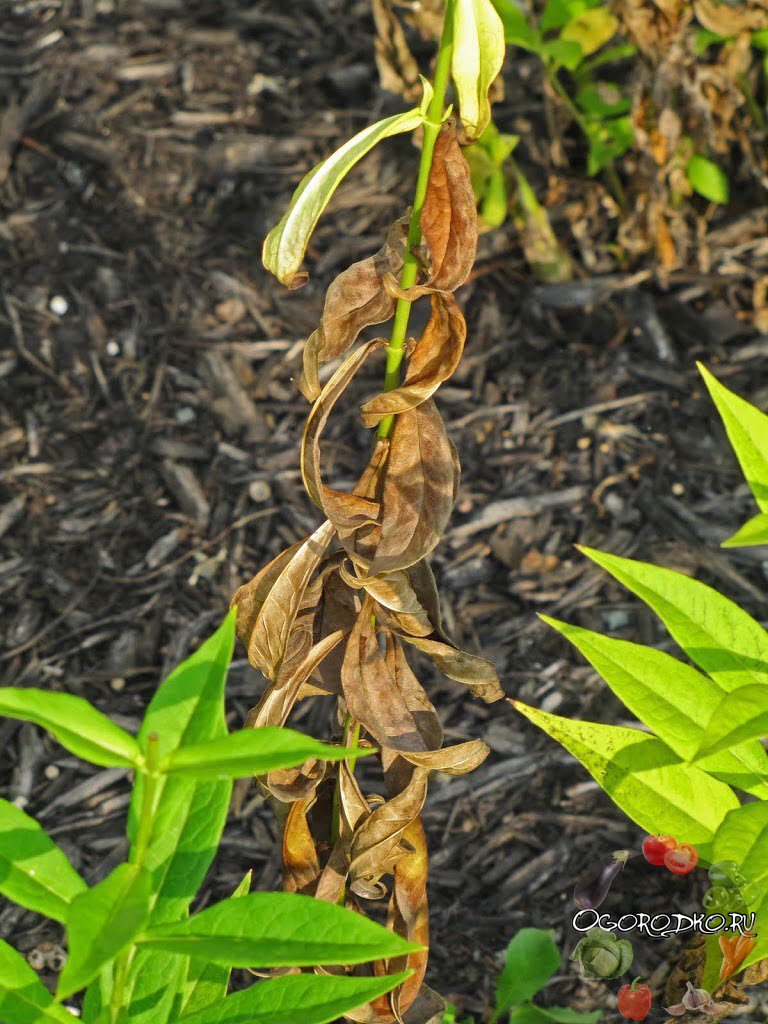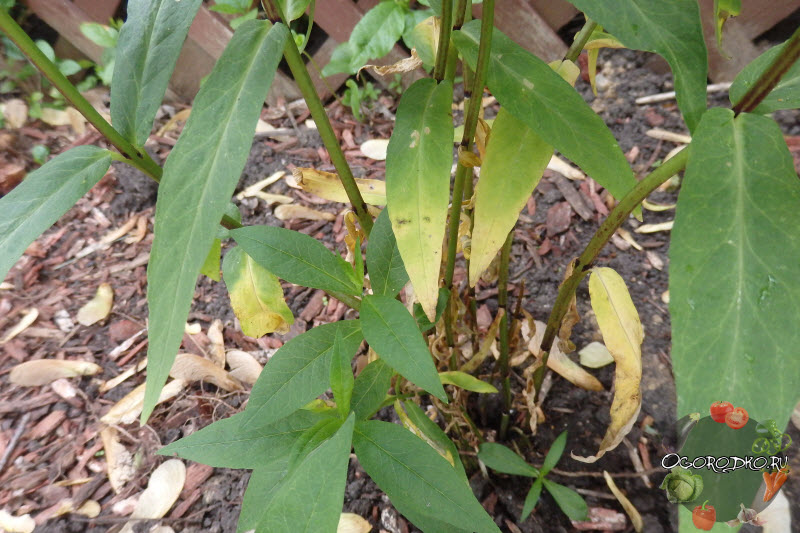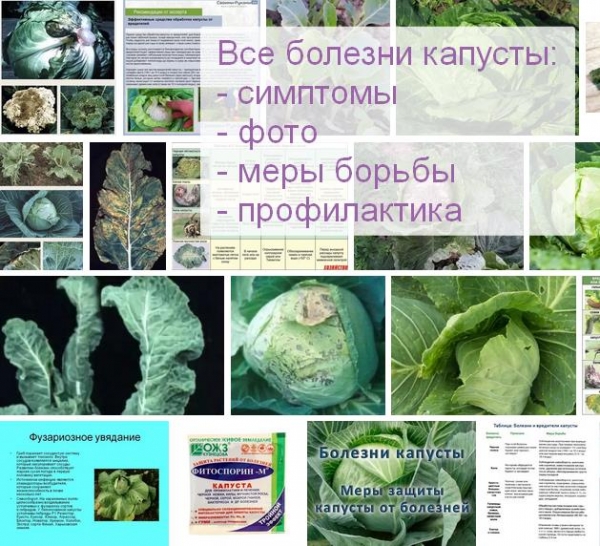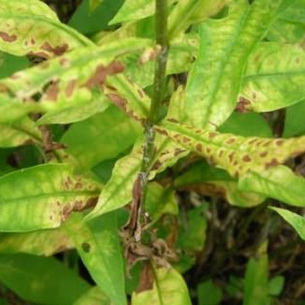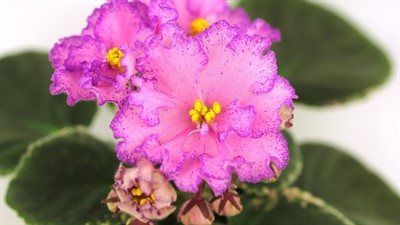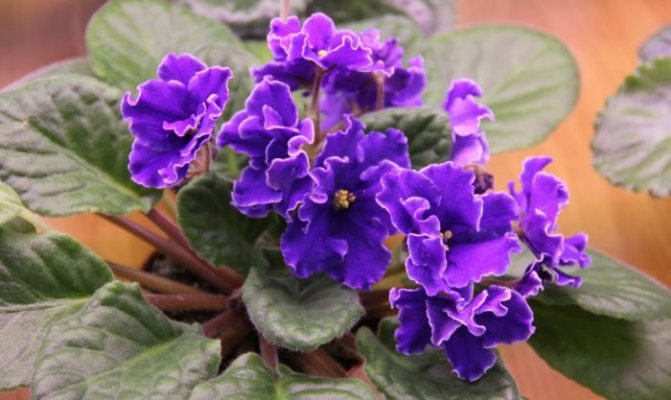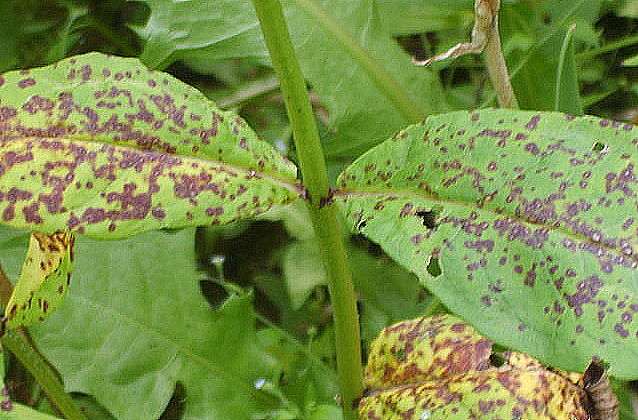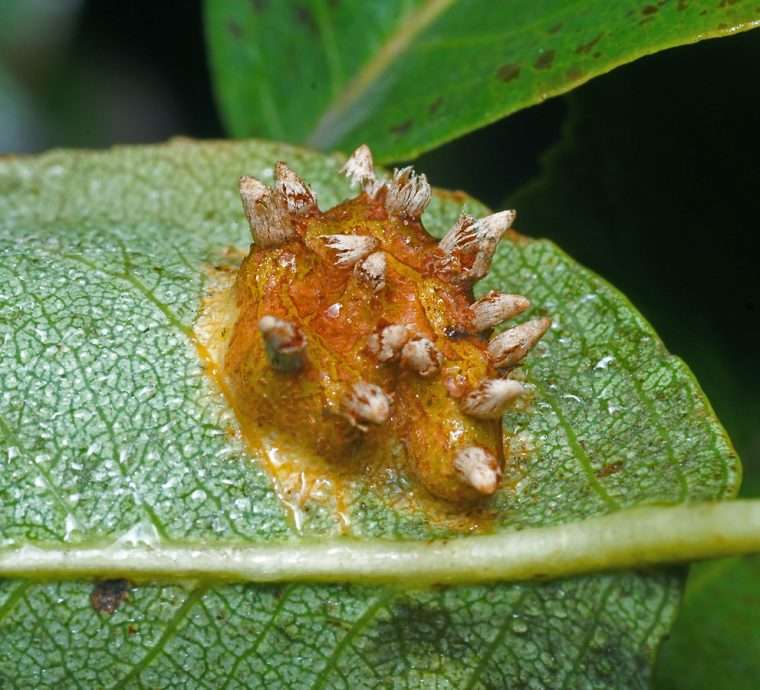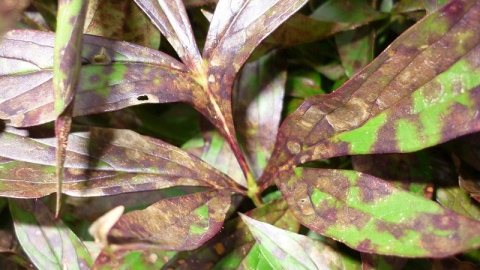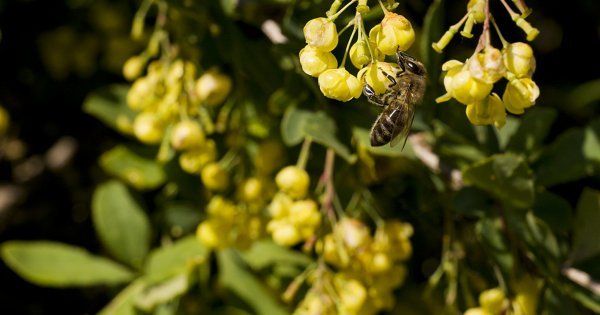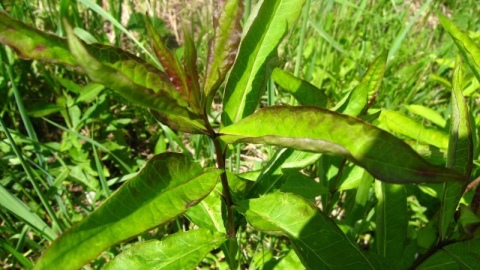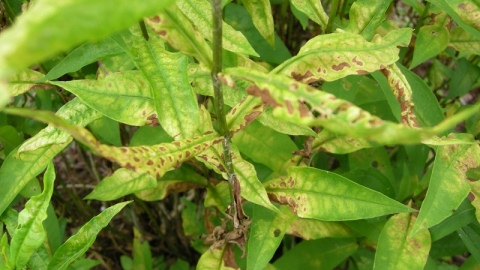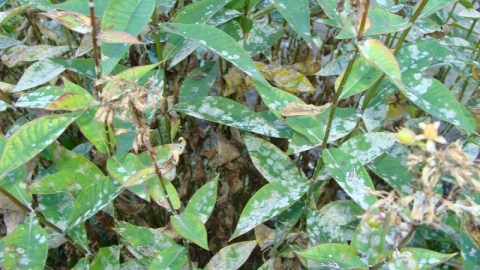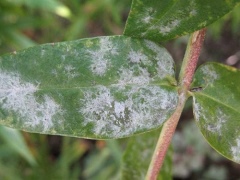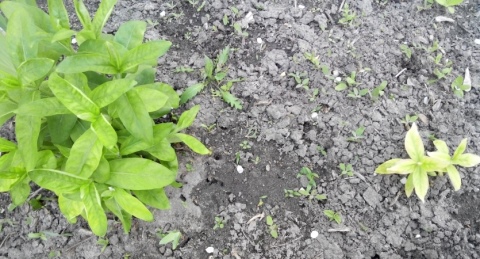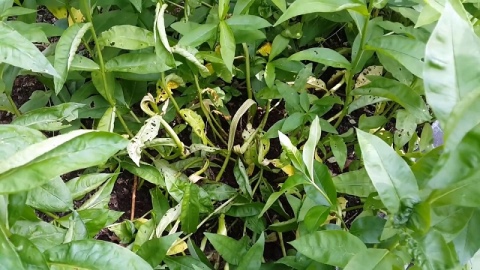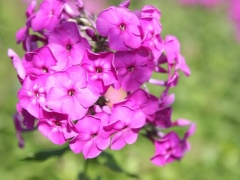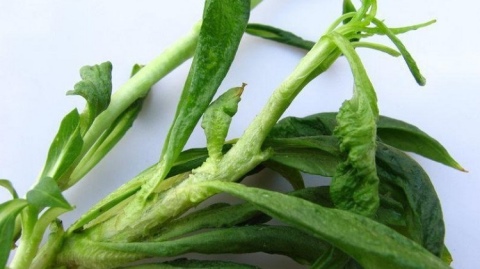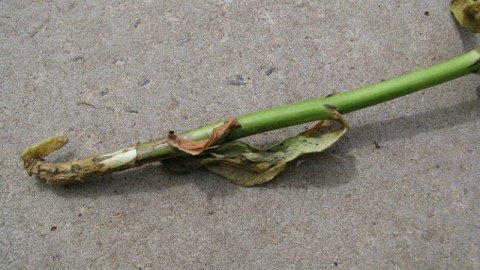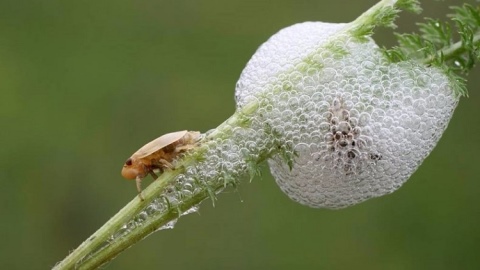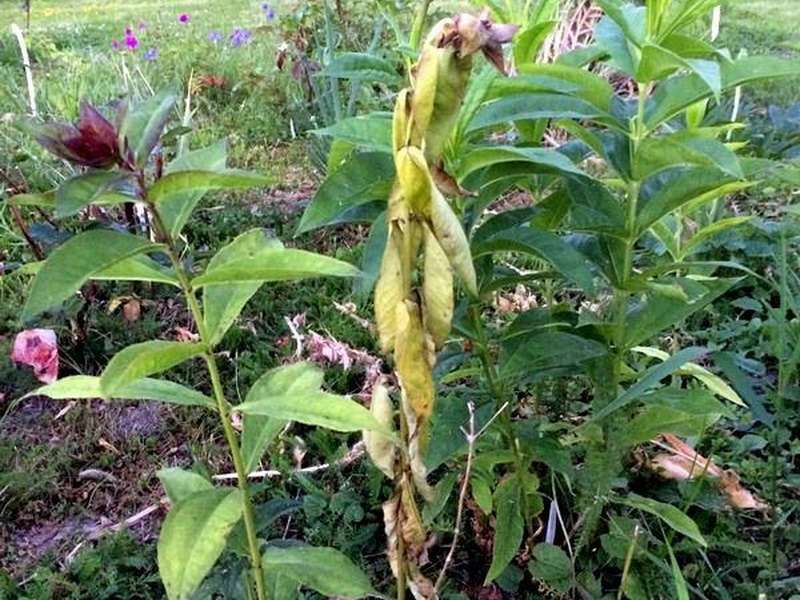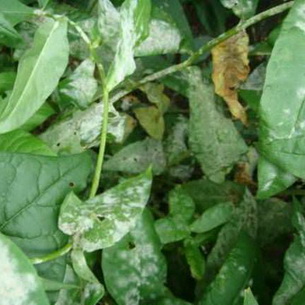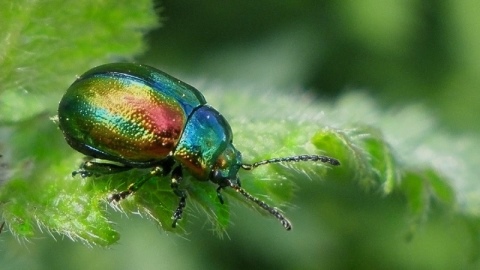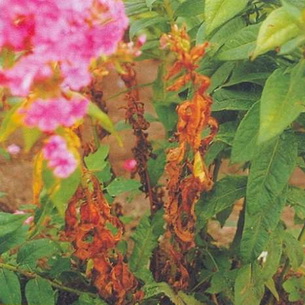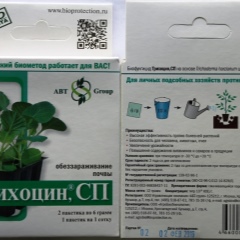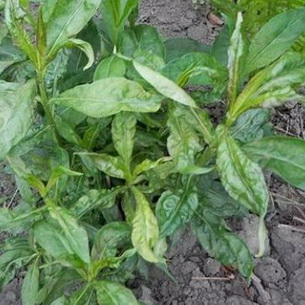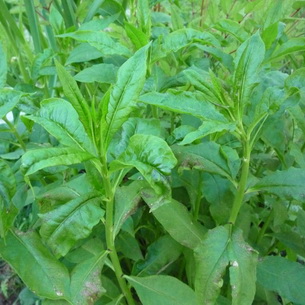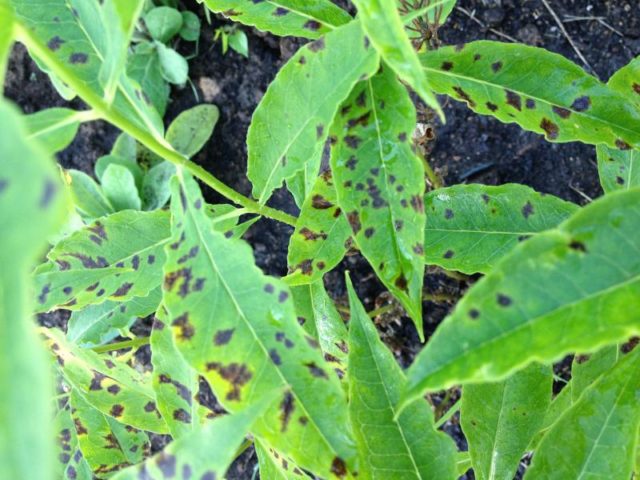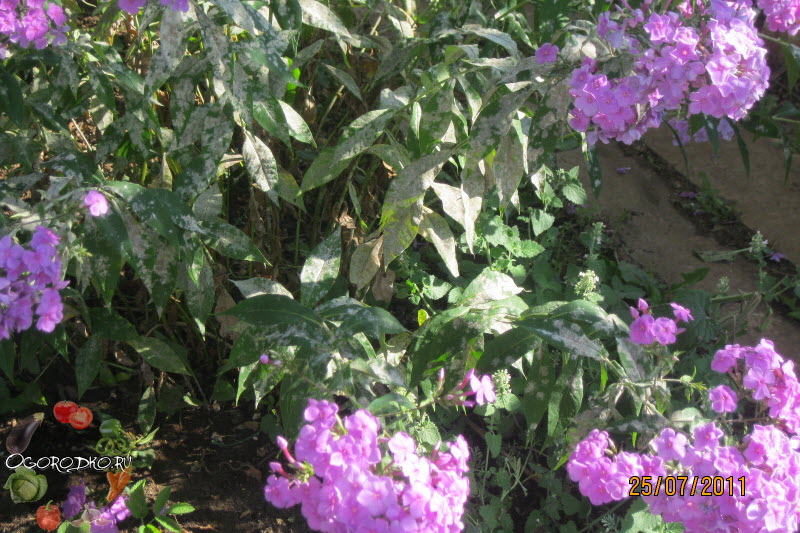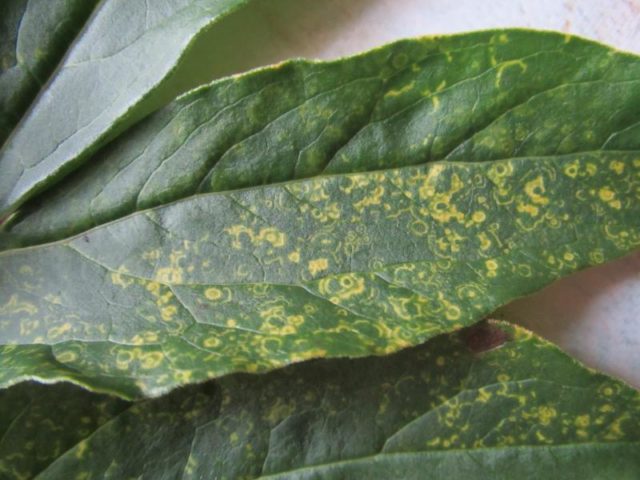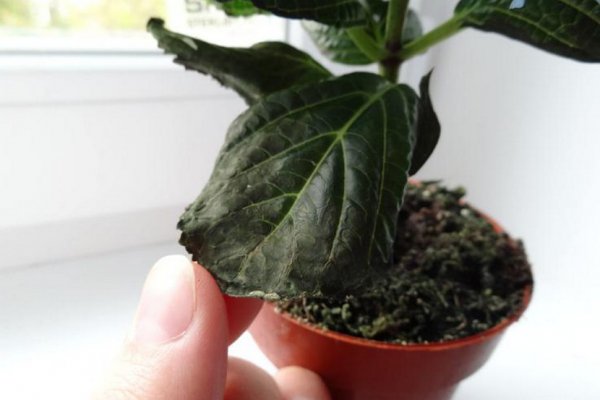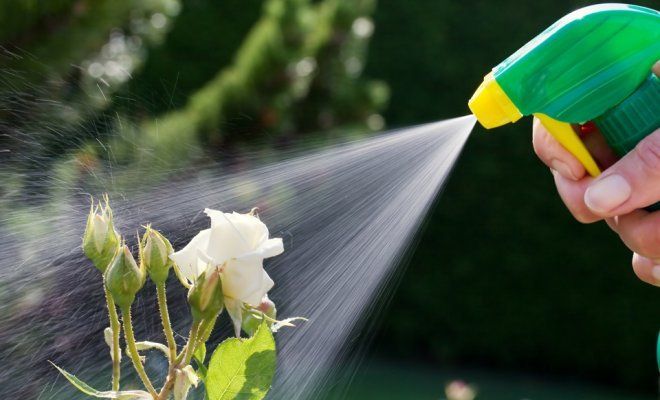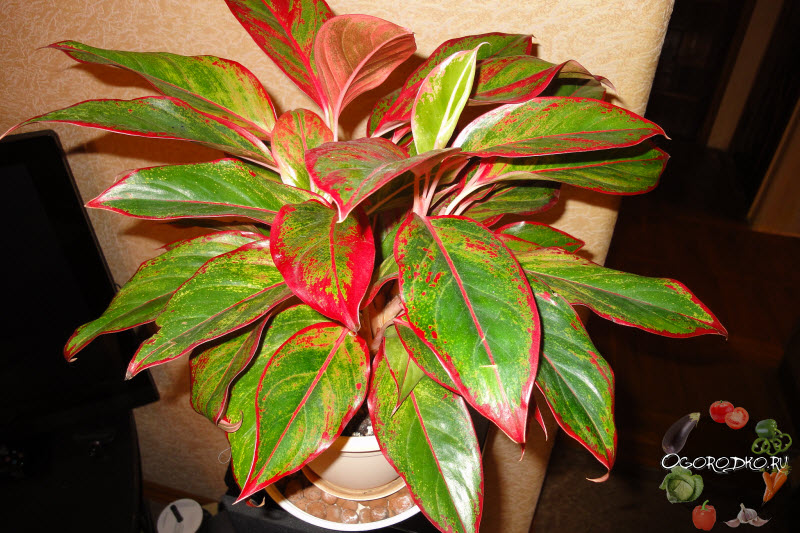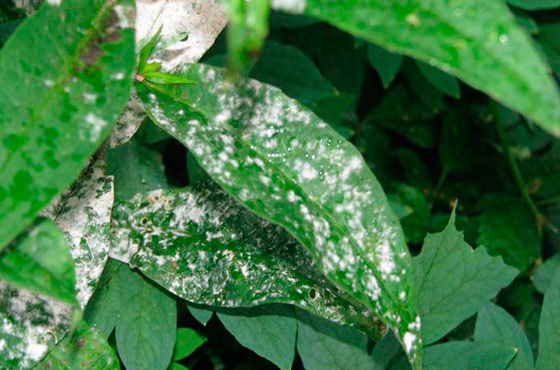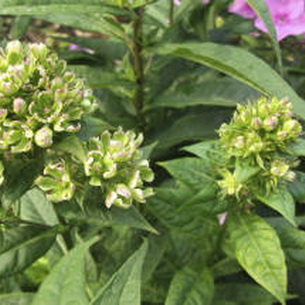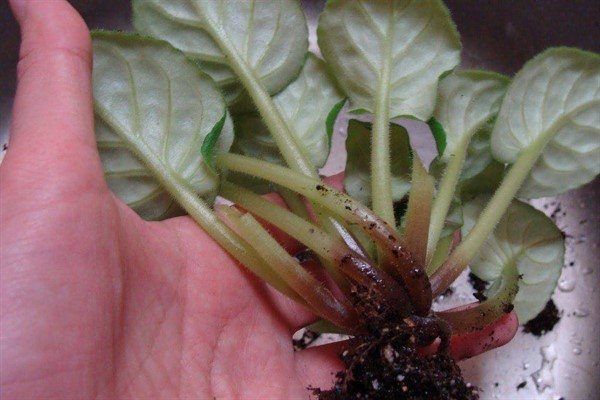Phlox
730. Why do the lower leaves of phlox turn yellow and dry prematurely?
To prevent this from happening, in the spring, as soon as sprouts appear, spray the plantings of phlox with a 0.1% solution (1 teaspoon per 7 liters of water) with Bordeaux liquid. Feed with ash several times over the summer, because phloxes need calcium and, moreover, they do not like acidic soils. Before budding, give a phosphorus-potassium supplement (1 tablespoon of each fertilizer per 10 liters of water, spending 0.5 liters under a bush).
If the foliage is light or the plants are weak, then at the height of summer, feed the phlox with an infusion of manure or weeds. After cutting, spray the planting site with Bordeaux liquid and apply the rotted compost directly to the rhizome. For a lush flowering, leave no more than 5-6 stems in each bush. Cut out excess and weak ones at the beginning of summer. Phlox should be planted after 5-6 years.
731. Regularly gray bloom appears on phlox leaves in summer. Advise what to do.
This is common powdery mildew. The mushroom is especially strong in wet and cold summers. Noticing such a plaque, immediately spray phlox with any preparation that contains copper, or use "Zircon" or "Fitosporin".
There will be no disease if the plants are sprayed with Bordeaux liquid or "Zircon" in spring and autumn or once a month water the entire bush with Fitosporin.
732. How do phloxes reproduce?
By dividing the bush at the end of August or by cuttings at the beginning of summer, but only while the stems are green. Lignified stems (or their lower parts) are not suitable for grafting. A strong stem is taken on the cutting, cut off at the root, the upper part is cut off, and the rest of the stem is divided into several with pruning shears, leaving 2 pairs of leaves on each. At the bottom pair, 3/4 of each sheet is cut off, and at the top, on the contrary, 3/4 is left.
The cutting is rooted in wet sand (5 cm layer), under which fertile soil is poured, placed over the planting arcs, covered with a double old film. Having placed the cuttings in the shade, plantings are sprayed daily in the morning and in the evening with water from a sprayer, directing the stream not to the cuttings, but moistening the soil. The most important thing is not to dry out the plantings.
In extreme heat, plantings are sprayed during the day. You can, of course, buy or make a foggy installation, but this is in the event that you propagate phlox for sale. 8-10 cuttings can be made from each stem. When the cuttings begin to grow new leaves, the film is removed, but the moisture of the soil is closely monitored.
When the plants grow up to 25-30 cm, they are fed with an infusion of manure or weeds, at the time of budding they give a mineral supplement with a complex fertilizer (3 tablespoons of azofoska or ekofoski per 10 liters of water). The entire flowering period and after it, phloxes can be transplanted (or sold), but with a good clod of earth.
733. How to make money on phlox? Growing phlox from cuttings. At the beginning of summer, before the lower parts of the stems are lignified, cut off the stem, divide it into parts so that each part has a leg and two leaves. Cut the leaves in half and plant them in the cuttings. At the end of summer, the rooted stalk will bloom.
These are the plants you usually buy from others, and now sell them yourself. On cuttings, you can use not only a large green stem, but also all the little things that are usually recommended to be cut. Since in each bush for more lush flowering it is still recommended to leave 3-4 of the most powerful shoots, you do not throw away the rest, but cut them and sell or exchange for other varieties.
734. Phlox bloomed beautifully for me, and suddenly they began to fade. Tell me what to do. You have outdated bushes.You probably read that in 4-5 years they need to be seated, but you did not. And the fact is that by the age of 5 they have a rotting middle of the bush and they need to get rid of it.
To do this, in August, dig up a bush, divide it in half, cut out the rotten middle and plant it either in a new place, or in the old one, but then change the soil in the planting pit. If, after transplanting, you water your phlox, then such a procedure will not affect its flowering in any way - as it bloomed, it will continue to bloom.
This text is an introductory fragment.
Verticillary wilting
The disease is provoked by microsclerotia of fungi of the genus Verticillium, which live on plant debris in the soil for up to 15 years.
The disease breaks out with foci. The main symptoms of the disease are the loss of turgor, that is, the fullness of the leaves with moisture, their yellowing, darkening and drying, a change in the color of the stems. The fungus enters plants through the root system, then moves to stems, petioles, leaves, and sometimes reaches fruits and seeds.

Verticillary wilting
You can see the mycelium of the fungus on the cuts of the stems in the form of a weak grayish bloom. The mycelium clogs the conducting vessels and does not allow nutrients and moisture to penetrate into the vegetative and generative organs of phlox. Most often, verticillary wilting of plants begins to hurt at the stage of preparation for laying the inflorescence.
It is possible to prevent the appearance of the disease by preventive measures - removal of plant residues, autumn-spring digging of the earth, soil treatment with biological products and fungicides.
Plants can be treated with drugs:
- "Trichodermin",
- "Glyocladin",
- Fundazol,
- "Maksim",
- "Vitaros".
Insects and pests
The listed phlox diseases with photos and their treatment will be incomplete without a list of pests that love to feast on tissues or plant sap. Of all insects, nematodes, cicadas, aphids and several other species can cause special harm. Let's take a look at the entire list.
Caterpillars
The emerging caterpillars of butterflies and moths quickly eat up the green part of the plants. For development, they use all edible parts, sometimes inflorescences. If you do not spray, then these voracious creatures can greatly spoil the phlox bites.
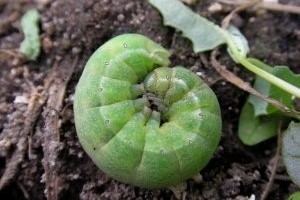
Phlox pests - caterpillars
Getting rid of the caterpillars takes patience and dexterity. First, you need to collect all visible pests. You also need to cut off any existing weeds. Next, the plantation needs to be treated with a fungicide. And as the flowers grow, it is worth inspecting whether new individuals have appeared.
Slobbering penny

Phlox pest - slobbering penny
Small larvae of the penny bug can settle on the underside of the leaf during their development, that is, in May-June. The larvae feed on sap, gradually dehydrating the culture. Foam leaves can be torn off and burned if the disease is single. In case of mass damage, the plants will have to be treated with Inta-Vir, making sure that the solution reaches the back of the leaf.
Slugs
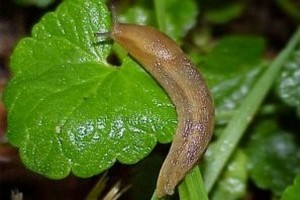
Phlox pest - slug
What garden can do without slugs in the summer? They are quite prolific and gluttonous. They eat almost all parts of the plant, especially preferring young growth. During the day it is very difficult to find them, but at night they get out of hiding.
Ways to fight
Gardeners have not yet come up with anything more environmentally friendly than the catching procedure. To do this, pests are simply collected by hand, or traps are placed on them. For example, a beer or yeast treat is sure to attract slugs. Also in the fight they use lime, ash, superphosphate, which are sprinkled on bushes in a circle. If the rain washes away the tracks, then the procedure is repeated.
Cruciferous flea
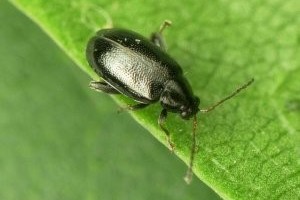
Phlox pest - cruciferous flea
Small black insects are especially dangerous for varietal phlox. They are especially gluttonous, despite their small size, they eat all parts of young shoots, leaves and buds.
Control methods
You can usually notice jumping insects when looking at the eaten leaves. Anti-flea dog shampoo can help fight them, and wood ash powder is also suitable. However, you will have to tinker with him for several weeks, carrying out treatments every 5 days. Plants can be powdered with tobacco dust. Such folk methods are well suited for systematic use. If you rarely appear at your summer cottage, it is better to use "Aktelik" or "Fitoverm".

Phlox pests - nematodes
Almost invisible to the naked eye, parasites are a terrible enemy of many plants. They suck in cell juice, leaving voids and swellings in the tissue. The plant withers, the flowers become smaller. You can recognize a nematode by swelling on young leaves or roots. Finding a nematode is difficult. Therefore, the flower is usually incurable from this parasite. If nematodes attacked phloxes, then you will need to part with the bushes, the area on which they grew, treated with formalin or lime.
Nematode
The most dangerous pest of phlox is the phlox race of the stem nematode Ditylenchus dipsaci var. phloxidis. This is a small translucent worm that settles mainly in the stems of phlox and feeds on their juice. The development cycle lasts from several days to several weeks, depending on the air temperature and humidity. The optimum temperature for nematode reproduction is 18-24C, and at temperatures above 40C, the nematode and its eggs die. Therefore, today the main way to combat nematodes is thermal. But this method is not suitable for phlox, its divisions do not survive after being treated with hot water.
The insidiousness of the disease lies in the fact that in the early stages it is rather difficult to distinguish a diseased plant from a healthy one; signs of nematode damage are clearly visible only in late June - early July. The main feature is the threadiness of the apical leaves, thickening of the stems, the plant becomes as if squat. Sometimes sick phloxes even bloom, but the inflorescences look pretty ugly. When a nematode infection is detected, first of all, it is necessary to exclude watering the plants from above, it contributes to the rapid spread of the disease, especially in warm weather.
A heavily affected plant dies. Not only phloxes, but also other plants suffer from stem nematodes. In nature, the nematode infects 400 plant species, it has the strongest digestive glands. In general, the nematode is the scourge of phlox. Developers of plant protection products have not yet offered anything radical to combat this disease in personal subsidiary plots. The nematicides allowed for use in farms are so dangerous that I will not even give their names, so as not to take a sin on my soul.
In the literature, it is recommended to cut the upper parts of the shoots in May to improve collections and save valuable varieties. The studies carried out at present allow us to conclude that early spring cuttings or harvesting of cuttings in the fall in order to improve varieties should be carried out at a soil temperature of less than 10C. Analyzes of phlox stems for nematodes in spring show that nematodes are not yet present in stems 5 cm high. The nematode is already present in the lower part of the stem at a height of 6-7 cm, but it is not yet present in the apical part. At such a height and a soil temperature below 10C, you can cut the tops of phlox in spring in order to preserve the variety and get rid of the nematode. When the stem height is 9-10 cm, the nematode has already reached the top of the phlox.
The most effective way to control a nematode is to manually cull the plants. Regularly inspect your plantings, you saw one or two diseased stems in the bush, immediately break them as close as possible to the roots, and in - a fire.
Peas, mustard, parsley, dill, marigolds, calendula are trapping plants. They accumulate the nematode. Alternate planting phlox and marigold.In the fall, carefully dig up the marigolds with roots and burn them. It is even better to sow dill between phlox, nematode infection and other diseases are sharply reduced. Dill can be eaten or seeds can be collected from it, the nematode does not harm people. Weeds are nematode accumulators, so try to keep dandelion, thistle, nettle, woodlice out of phlox plantings. Slugs eat diseased leaves, and secrete a nematode.
Nematoda does not live in the ground. Its larvae are surprisingly tenacious. They hibernate in regeneration buds, at the base of shoots, in rhizomes and in dry plant debris. Therefore, in the fall, you need to carefully clean the beds. In the spring, nematodes penetrate the growing stems and, together with them, rise upward, affecting the plant.
Preventive measures
Any disease is easier to prevent than to cure, so we suggest you familiarize yourself with the care procedures that will keep the lilies intact.
Always pre-process the planting material. Preparations-disinfectants "Maxim", "Prestige" are well suited.
Examine the bulbs: they should be dense, elastic, with no signs of decay or damage.
Plant lilies in well-lit areas as they love sun exposure. If the beds are shaded, it will attract pests, many of which are afraid of direct sunlight, and flowering will slow down a little.
When planting lilies, keep a sufficient spacing between them (about 25 cm), as they do not like thickening
Otherwise, if one plant is affected by a fungus, virus or parasite, the entire colony will inevitably fall ill.
When digging the onions in the fall, do it carefully so as not to damage them.
Watering lilies should be frequent and abundant. The optimal hours for this are early in the morning and late in the evening.
Watering should be closer to the roots, use only warm, settled water.
In the spring, when the first leaves are blooming, you need to spray the bushes with copper oxychloride.
Provide adequate ventilation in the room where you are storing the planting material.
Most harmful insects will refuse to attack your lilies if they are fed with fertilizers containing potassium and phosphorus.
The smell of dill, garlic, marigolds repels rodents and many other pests. Plant them between the lily beds.
Treat the soil with formalin regularly.
In the autumn, after digging the bulbs, it is necessary to dig up the ground well. It is recommended to burn the remains of plants.

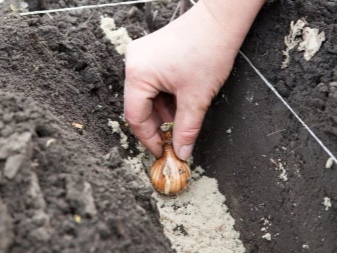

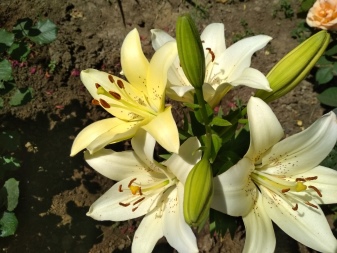
See below for more details.
Fungal diseases
Very often phlox diseases are associated with parasitic fungi, for the development of which moisture and a certain temperature are needed. The favorable combination of humidity and temperature determines their mass development and, accordingly, the appearance of diseases. The spread of fungal infection occurs with the help of wind, water, insects, people who care for plants. The infection persists on the affected plant debris, in the soil, in sowing and planting material, as well as on perennial weeds.
It should be noted that the degree of susceptibility to various types and varieties of phlox fungal diseases is not the same.
To carry out preventive (preventive) measures, it is necessary to know the signs of the main diseases of phlox, and diseases of fungal origin, as a rule, are mainly characterized by the appearance on the leaves and shoots of plants of various kinds of spots, necrosis and plaque.
The most common and harmful fungal diseases affecting phlox are:
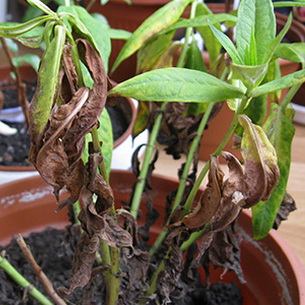
Verticillium wilting (causative agent - fungus Vnticillium albo-atrum)

Powdery mildew (causative agent - fungus Erysiphe cichoracearum f. Phlogis)
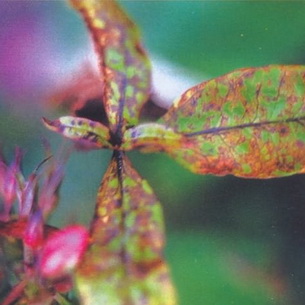
Phomosis (causative agent - mushroom Phomaphlogis)
Strict adherence to agrotechnical methods for caring for plants - correct watering, the use of mineral fertilizers with increased doses of potash, timely preventive measures - increases the resistance of phlox to phytopathogenic fungi.

Verticillary wilting. The causative agent of the disease is the fungus Verticillium albo-atrum. Withering of phlox shoots is associated with damage to the plant's conducting system.A soil pathogen that enters the vascular system of a plant through a root system damaged during planting or tillage (for example, cuts when loosening) or wounds caused by pests (for example, a wireworm). Then it spreads, clogs it and poisons it with its toxins, as a result of which there is a sudden wilting of leaves and shoots. The leaves turn yellow, turn brown and dry out, remaining hanging on the plants.
Most often, the symptoms of powdery mildew are characterized by drooping of the leaves and tops of individual shoots on the phlox bush, which is associated with a loss of turgor by the cells and tissues of the plant. The main reason for the death of shoots is the lack of nutrients and water in the plant, which is caused by the cessation of their flow through the dead vessels. Outwardly, wilting leaves and shoots usually look healthy and the disease resembles wilting and drying out from lack of water, but darkening and vascular necrosis can be seen on the transverse sections of the shoots, and under the microscope, mycelium is found in them.
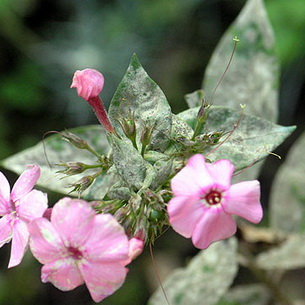
Powdery mildew is focal in nature, especially pronounced on acidic and light soils due to their weak microbiological activity. On rich humus soils with high biogenicity, the disease manifests itself less strongly. The temperature favorable for the development of the disease is about 25 ° C, so the spread of the pathogen increases in July and August, and with a cold snap, in September, at the base of the stem, sometimes new healthy shoots develop. The introduction of large doses of nitrogen fertilization also contributes to the development of the pathogen. According to some experts, the development of the disease can be provoked by waterlogging of the soil.
The primary source of infection is contaminated planting material, seeds collected from diseased plants, poorly rotted manure, compost and sawdust. It has been noticed that strawberries, nightshades and pumpkins are especially susceptible to Verticillium albo-atmm and are its accumulators.
The pathogen in the form of mycelium remains in plant debris, and in the form of microsclerotia in the soil retains its viability for up to 15 years. Distributed everywhere.
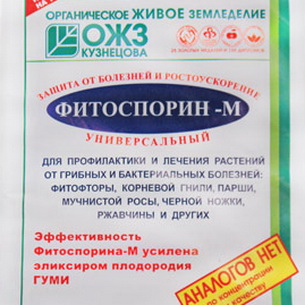
Good results in the fight against verticillosis are obtained by the introduction of the biofungicide Trichodermin into the soil during the growing season of plants at a dose of 2 g per plant or its analogues, for example, Glyocladin (one tablet is applied under one plant). Particularly valuable plants can be watered with a solution of the biofungicide Fitosporin-M (strictly following the manufacturer's recommendations), diseased plants can be etched in the same solution, after which they are planted in a new place. For dressing rhizomes, you can also use 0.2% solutions of fungicides Vitaros or Maxim.
In case of mass infection and death of plants from powdery mildew, it is not recommended to occupy these areas for phlox and other crops susceptible to this disease for 10 years.
It is necessary to collect and be sure to destroy all affected plant debris at the end of the growing season.
Fungi
Another reason for the yellowing of the leaves in phlox is the bottom. Fungal microorganisms enter the plant through cracks in the stem. Very quickly, a deadly mycelium grows inside the bush, gradually killing the plant. The first symptom is brown spots on the leaves. As they spread, the plate twists and dies off. Mushrooms destroy all phlox tissues, disrupt regulation processes, and lead to severe intoxication.
Septoria. Also called white spot caused by the fungus Septoria phlogis. Leaves on infected plants begin to turn brown, become covered with a dark border, and fall off. After identifying the problem, the fallen leaves must be collected and burned, and the plant itself must be treated with Bordeaux liquid.
Verticellosis wilting. A rare disease that appears at a time when phlox begins to bloom. Signs of a problem - leaves with young shoots rapidly turn yellow and fall off.The mycelium appears on the roots of a flower, most often in spring, with high humidity. The base of the bush is covered with a white coating, which causes it to blush. The settled fungus multiplies rapidly, feeding on phlox juices. To eliminate the problem, it is necessary to dig up the infected bush, remove the soil from the roots, then place the lower part of the plant in a solution of Bordeaux liquid for 20 minutes. At this time, process the land with copper sulfate, then return the bush back.
Powdery mildew. Summer disease affecting the lower leaves of flowers. White spots appear on them, similar to cobwebs. Gradually, they grow, completely affecting the entire bush. To get rid of the fungus, you will have to spray phlox and neighboring plants with Topaz. As an addition, it is useful to treat the plant with a soda solution.
Fomoz. Another fungal disease that manifests itself during the budding period of phlox. It affects the base of the stem, due to which its structure changes. Jaundice appears on the leaves, gradually they dry out. Unfortunately, it will not be possible to completely save the flower, only its healthy parts are the stalk. To do this, the top of the phlox must be cut off, treated with any antifungin and re-planted. It is better to get rid of diseased stems, and to heal the earth with the help of "Tiazon".
Rust. Summer sickness caused by spores of rust fungus. It affects the aboveground part of the flower garden. The manifestation is very characteristic - brown, brown spots on the leaves and stem. Quite a dangerous enemy, difficult to treat. It is highly fertile: in just a few weeks, millions of new fungal spores appear in one phlox bush. This process is facilitated by high humidity and an excess of nitrogen in the soil.
At the first symptoms of the disease, it is important to take a number of preventive measures: treat the flower garden with fungicides, sprinkle the soil with ash, cut off the affected greenery, spray the bushes with iron sulfate or preparations with copper.
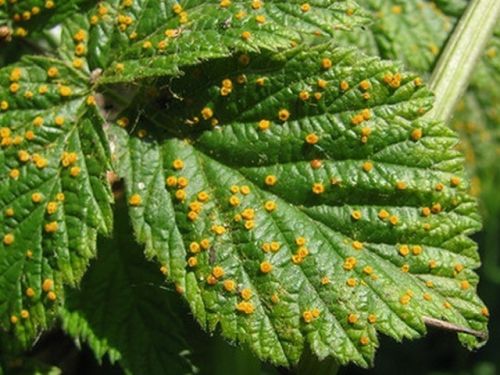
Rust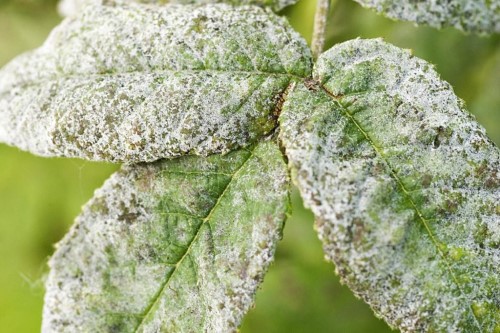
Powdery mildew
Treatment methods
What to do if a disease is identified or the problem is not diagnosed accurately enough? For example, yellowing of the lower leaves may not necessarily be the result of an infection. Normally, it manifests itself in the fall, with the onset of leaf fall. In addition, overflow or lack of moisture, excessive shading, prolonged contact with the sun's rays also cause similar symptoms.
If the sources of problems nevertheless turn out to be an infection, a virus, damage to roots, stems, leaves by insects, you should pay attention to the methods that can be used to treat the diseases that have arisen. Usually, it is proposed to fight in several ways.
- With a viral lesion - mosaic or variegated leaves - it will not be possible to bring the plant back to life. The fight is rather for the immunity of other landings. The affected phlox is dug up and burned.
- With powdery mildew, rust and other fungal diseases, the main thing is to treat the plants in time with preparations containing copper. It is usually done prophylactically, but emergency treatment can also be used. First, all damaged plant parts are completely sprayed with a solution. Then they are eliminated - the shoots are cut off and burned.
- When affected by a nematode, the bush is destroyed along with the root. Especially valuable plants are saved by early spring separation of the most healthy shoots up to 4 cm in height, together with a part of the rhizome. The seedlings obtained in this way must be rinsed with running water, then sent to the ground under a shelter. The mother plant is dug up and burned.
- With verticillary wilting, the bush can be cured. It is recommended to rinse the roots with soaking in the “Maxim” preparation. Then the plant is transplanted by placing it in the well with the "Trichodermin" agent. A measure of disease prevention will be soil deoxidation with ash or lime.
- With phoma, it is quite difficult to get rid of the disease. The fungus affects the bushes for 2-3 years of life.If they do not represent a breeding value, it is better to immediately decide on burning. You can save individual parts of the plant by choosing healthy cuttings and keeping them in the Fundazole solution before planting.


Viruses

Another reason why phloxes show yellowing of foliage is viral diseases. They cause irreversible consequences on the state of phlox: mutations appear, the flower becomes smaller, the leaves begin to dry. The described problems cannot be treated, therefore, you will have to get rid of the infected bushes.
There are no viruses that exclusively prefer phloxes - the described flowers suffer from the same diseases as other garden plants.
There are several ways of infection: gardening tools, tops, seeds, pests.
What control measures should be taken to destroy the most common viruses that infect phlox?
- Leafy curl. The causative agent is the cucumber mosaic virus. The infected plant changes rapidly: yellowness appears on the leaves, spreading in the form of a mosaic, the stem is covered with scabs, the buds do not bloom.
- Necrotic spotting. The causative agent is the same (the cucumber mosaic virus), but the manifestations are different. Small brown spots appear on the phlox leaf plate. They spread quickly, merge with each other, lead to the drying out of the entire bush.
- Ring spot. The flower is affected by the Longidorus nematodes at the beginning of the growing season. The leaves are covered with a yellow ring pattern, deform and fall off.
- Rattleness. Called Tobacco rattle or tobacco rattle virus. It is carried by nematodes, manifests itself during the period of active development of phloxes. The first symptom is that the leaves begin to become covered with green-yellow spots, spreading in rings. Due to the disease, the growth of the flower slows down, flowering does not occur.
- Threadedness. The causative agent can be both cucumber mosaic and nematodes. The leaves of diseased phlox begin to mutate, becoming covered with denticles along the edges. A pronounced dwarfism is noticeable, the growing shoots are too fragile and small.
- Variegatedness. One of the most dangerous diseases transmitted by the rash mosaic virus. It affects the production of anthocin, a pigment that colors the plant in its inherent colors. Because of this, asymmetric light stripes appear on the leaves and buds, and pronounced spotting appears.
The main problem of these viruses is that not only phloxes are infected, but also the crops near them.
In the early stages of infection, the situation can be corrected by spraying all bushes with copper-containing preparations.


